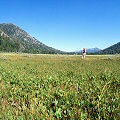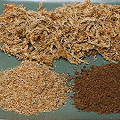Q: About peat.

Californian peatlands

peat: lower right
A: Most carnivorous plants require acidic soil, of the sort with characteristics
that match their wetland
origins. The soil in these wetlands is derived from partially decayed plant matter and is very high in organic content.
Despite the high organic content, the soil has a high acidity and almost no nutrient availability.
It is called "peat"
An important
plant in acidic wetlands is a moss called Sphagnum (Sphagnum is the name of the
genus). When Sphagnum moss decomposes slightly, it produces Sphagnum peat
moss. It is often marketed as simply "peat moss." Sphagnum peat moss is so useful to
carnivorous plant growers that they often just call it "peat".
Please be aware, though, that any partially decayed plant matter is called peat. So be a little cautious when
referring to peat moss by the convenient name peat. I'll assume you understand the distinction; throughout the FAQ when I refer
to peat I mean Sphagnum peat moss. Do not confuse peat moss with
sedge peat (which is derived from decayed sedges, a grasslike plant)! I have been told by FAQ-reader N.M.
that in the UK you can use a product called "Moorland Gold", which is an ecologically-sound peat alternative, and
which works well on at least Drosera and Sarracenia.
Peat is available in various quantities, and in my experience it is
best to buy it in large volumes. In the USA, it is actually still sold in "bales"
(can you believe how backwards this great country is?). A bale is an
antiquated volume measurement equivalent to 3.5 cubic feet. (Feet....sigh.)
Yes, a bale is a lot of peat, but in time I use it all. If
you buy smaller bags of peat, beware: they are often prewetted (so you are paying for water), but
worse still, small bags are sometimes treated with wetting agents, compounds such as soaps
which may be harmful to some carnivorous plants---do you want to take that chance?
Dry peat is often compressed and is bone dry. Peat is difficult to wet, so do not use
it in your soil mixes without first moistening it. If you are moistening small volumes,
crumble it into a powder with your hands, put it in a deep tray, then add an equal volume of
water. The peat will float. Grab a handful of peat, submerge it, then squeeze the air out. Keeping
the peat underwater, let it re-expand. It will draw water in and become wet. Voila!
Moistened peat is a few shades darker than dry peat.
The majority of growers feel that peat by itself is too dense for most carnivorous plants and that it does not allow
aeration in the soil. I agree. This can be circumvented by adding sand to the peat. I recommend a 50/50 mix
for a general potting mix that works on a huge number of carnivorous plants, including the ones you are
likely to have as a beginner (except for Nepenthes and Pinguicula).
Peat is mined from bogs---wild areas in which carnivorous plants grow. So every time you use a chunk of peat, you
have used up some carnivorous plant habitat. Don't waste your peat, OK?
Kay Klier submitted a few excellent notes on
peat and Sphagnum, and describes the situation more.
After a few years, peat in a carnivorous plant pot gets old and mucky. Instead of throwing it out, use this stuff in
your garden. It is an excellent way to enrich the garden soil with organic material.
Page citations: Rice, B.A. 2006a; personal observation.